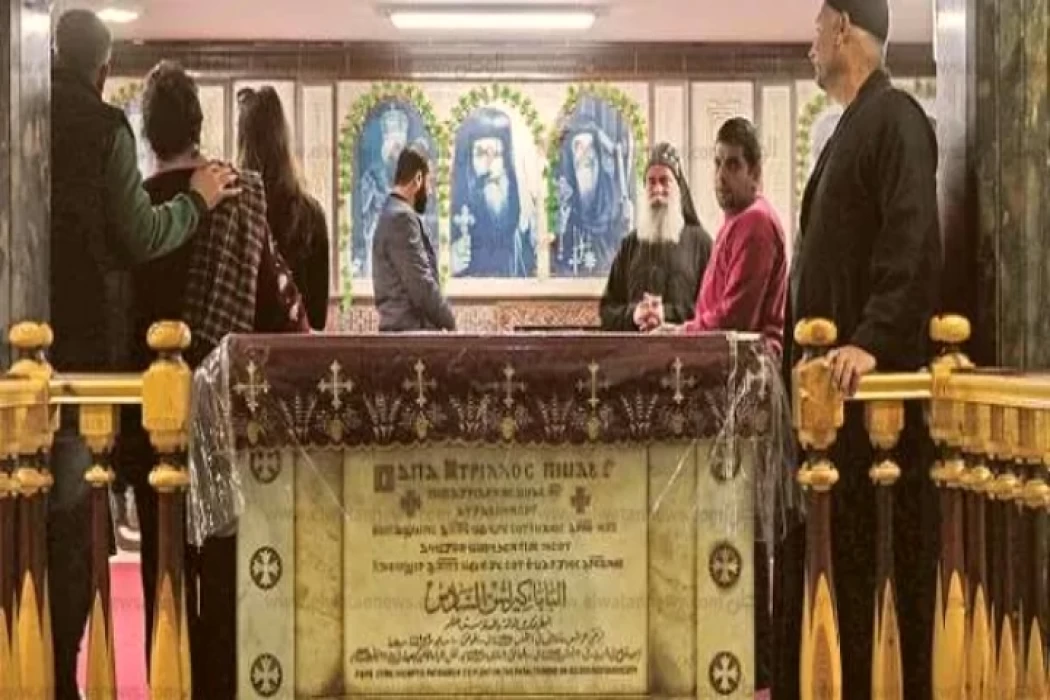
Pope Cyril (Kyrillos) VI
His Holiness Pope Cyril (Kyrillos) VI died on March 9, 1971, and he was buried under the altar of the cathedral. On November 25, 1972, his body was transferred in a solemn ceremony to the monastery of the martyr Saint Menes in Meriut according to his desire to be next to his patron saint Menes
The archeological area of the Deir Menes has been registered in the UNESCO of the Most Important Archeological Areas. In 1979, UNESCO has paid special attention to the archeological site of Abu Mina and approved it among the 57 areas as a human heritage that must be taken care of and preserved globally. In this regard, it published a book in 1982, containing a brief description of each of The history of the monastery dating back to the arrival of the remains of the martyr "Saint Menes" and their settlement in its ancient shrine of antiquities around 312-315.
The first church of the martyr in Meriot was built between 320 and 325 AD during the reign of King Constantine the Great, and the number of visitors and seekers of miracles
When the number of visitors increased, Bishop Theophilus, Pope 23, built a vast cathedral east of the first church. He also renovated and expanded the first church, and built a great baptism in the west.
The city, with its churches, became coveted by foreigners and raids of the Turkish Berbers and Persians until the 13th century the town and its churches were extinct fields because of the extensive vandalism that befell it and the lack of security in it. Then the body of the martyr Saint Menes moved through a long journey from the Mariout
Archeological finds of the area began in 1905 with the work of the German scientist Kaufman, followed by other research at intervals of the Greco-Roman Museum in Alexandria, the Coptic Museum in Cairo, and others.
And during the reign of His Holiness Pope Cyril VI, the area on which the modern monastery is located completely adjacent to the archeological area was purchased and reconstruction began again and its area reaches 15 acres.
The shrine is separated from the nave of the church, a hollow wall that houses about 15 pieces of the Pope's belongings, and is closed with glass, in order to ensure visitors' safety. It includes a silver cross set with a green stone in the middle, his latent clock, which was stopped with his death at eleven to a third, and his make-three, which resembles a leather belt containing 12 crosses. The monk wears it when he becomes autistic or when he advances spiritually in the monastery and wears it after holding special prayers.
His owner is obliged to submit to excessive monastic and ascetic laws. Visitors write down their orders in a pot at the top of the mausoleum. The number of visitors to the monastery increases on the feasts of saints, official holidays, and on Fridays and Sundays, where they enter the shrine spraying the sign of the cross, and head quickly from the tribal entrance to the sea to take the blessing, while some of them stay for long periods subsequent to the Pope's body, talking about their problems
The monastery kept three pairs of shoes for the pope, each of which varied according to the situation. The first is the leather shoe, which lasted in its foot for years unchanged, due to its asceticism in life, the second is the "slipper" for its internal movements in monasteries among monks, and the third is the cloth shoe dedicated to the prayers
Latest Articles
Admin
Seabourn Sojourn Cruise Stops in Safaga Port
The Seabourn Sojourn, the flagship vessel of Seabourn Cruise Line's ultra-luxury fleet, was built in 2008 at the T. Mariotti shipyard in Genoa, Italy. Measuring 198 metres, it can accommodate up to 450 guests in its 225 spacious all-suite staterooms.
Admin
Norwegian Sky Cruise Stops in Safaga Port
Norwegian Cruise Line operates a cruise ship called the Norwegian Sky. It was constructed in 1999 and can accommodate 2,004 passengers in addition to 878 crew members. The ship has several dining establishments, lounges and bars, a spa and fitness center, swimming pools, and a number of entertainment areas.
Admin
Explora II Cruise Stops in Safaga Port
Explora II, the second vessel in the Explora Journeys fleet, sets sail in 2024 to redefine luxury cruising. With 461 ocean-front suites, 9 culinary experiences, and 4 pools, this haven of sophistication and sustainability promises an unforgettable "Ocean State of Mind" journey to inspiring destinations.
Admin
Mein Schiff 6 Cruise Stops in Safaga Port
The Mein Schiff 6 is the latest cruise ship in the renowned TUI Cruises fleet, offering passengers a luxurious and sophisticated cruise experience. At 315 metres long, this floating resort features a range of dining options, entertainment, and recreational facilities, including a spa, fitness centre, and sports amenities.
Admin
Mein Schiff 4 Cruise Stops in Safaga Port
When the Mein Schiff 4 cruise ship docks in Safaga, Egypt, passengers are granted access to a realm of ancient wonders. Aboard this state-of-the-art vessel, guests can embark on meticulously curated shore excursions that showcase the region's most iconic landmarks, including the Giza Pyramids, the enigmatic Sphinx, and the remarkable tombs and temples of the Valley of the Kings in Luxor.
Admin
MS Europa Cruise Stops in Safaga Port
The Silver Moon, Silversea's latest flagship, is a luxury cruise ship that offers an exceptional travel experience for Venezuelans exploring Egypt. With a capacity of 596 guests and an impressive 40,700 gross tonnes, the Silver Moon maintains the small-ship intimacy and spacious all-suite accommodations that are the hallmarks of the Silversea brand.













